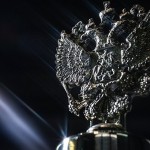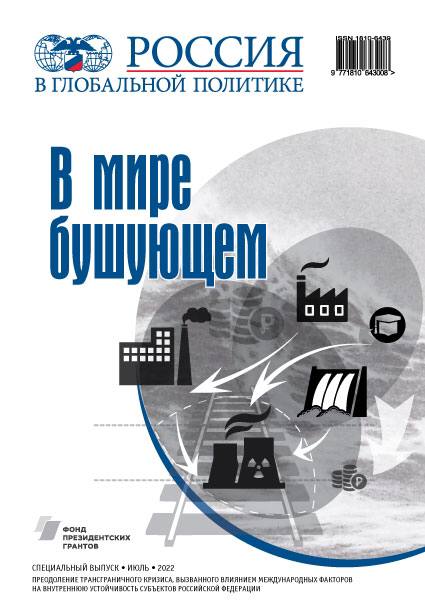Sergey Karaganov: How the World Looks From the Russian Perspective
In the future, a duumvirate may emerge in Central Asia, in which China will provide investment and resources, and Russia will contribute security and geopolitical stability.
Let me start with global trends. The era that began with the end of the Second World War is now over. That period was characterized by a relatively orderly and stable system of confrontation. In fact, the end of the Cold War did not mean the emergence of a new order. There was a hope that the main centers of power would establish relations based largely on cooperation. Instead, an attempt was made to build a unipolar world, which predictably failed. To all appearances, the world is now being swept by a wave of turbulence and fierce competition, if not a struggle of all against all. We are witnessing a rapid redistribution of power. The rules of the second half of the 20th century no longer work: absolute respect for sovereignty and territorial integrity, non-interference, at least openly, in the internal affairs of other states, and respect for the interests and security of at least big powers. All these principles the ideologists of the “unipolar moment” sought to repeal. However, nothing has been invented to replace them, while attempts have failed to adapt the former principles to the new reality.
New macro-tendencies are tentatively making their way through this chaos, which may shape the contours of a new world.
The first such tendency is the emergence of a new kind of bipolarity. Strictly speaking, contrary to conventional wisdom, bipolarity never existed before. Or, rather, it existed only in the late 1940s and the 1950s until objective circumstances and the mistakes of the Soviet leadership resulted in the confrontation with China. Thanks to the shrewd diplomacy of Henry Kissinger and Richard Nixon in the early 1970s, there emerged de facto a tripolar system of relations. Together with a group of expensive and unreliable allies, the Soviet Union had to confront the United States and the West all over the world, and China in the East. The Soviet Union had an unenviable geostrategic position.
At present, two centers of the world economy and politics are taking shape. Having realized the futility of its hopes to establish a unipolar world, the United States has adopted a policy of containing China and building a new U.S.-centered configuration around itself, using mainly economic and political tools. The first step was the launching of the Trans-Pacific Partnership with a group of Asia-Pacific countries. Its members do not include ASEAN countries or even South Korea, which has yet to make the final choice regarding its geo-economic orientation. And, of course, China remains an outsider, in accordance with a strategy largely aimed at limiting Beijing’s influence. Simultaneously, the U.S., together with part of the European elites which are afraid of their own weakness, is working on the Transatlantic Trade and Investment Partnership. Much is being done to resume the standoff in Europe and even renew systemic military-political confrontation on the subcontinent in order to prevent continental Europe’s rapprochement with Russia and China.
The future of both the TPP and the TTIP is not clear yet. They may succeed only partially or they may even fail. But the tendency is obvious: the “old” West, which dramatically lost ground in the 2000s after a seemingly spectacular victory in the 1990s, is now trying to reconsolidate its position.
At the same time, China is turning into a first-tier superpower and may well become number one in the world in terms of aggregate power during the next decade. It will not surpass the U.S. in terms of GDP per capita in the foreseeable future and will not exceed the U.S. in military power, although it will reduce the gap between them. Yet thanks to its authoritarian political system, China can direct many more resources into achieving its foreign policy goals. China’s soft power is in its enormous financial capabilities and its market, which is attractive even to competitors. Step by step, in order to avoid any suspicion of ideological expansion, Beijing is beginning to offer its own model — “the Chinese way” — to the rest of the world, especially the developing world, as an example to follow. Simultaneously, the Chinese economy is slowing down, thus seriously holding back global economic development.
Having met with growing resistance from the United States in the Pacific, that is, in the East, China has turned to the West. Beijing has proposed the “One Belt, One Road” strategy, which includes the Silk Road Economic Belt project, for intensive economic and logistical development of regions southwest and west of China (and involving Europe in the long run). This strategy aims to create a belt of stability and economic development around China and envelop it with new markets and friendly powers. Russia has finally commenced its long-overdue economic and political turn towards the East. Most experts predicted an almost inevitable clash between Russia and China in Central Asia. However, Moscow and Beijing had the wisdom to avoid confrontation by converting their potential differences into a potential for cooperation. In 2015 they reached an agreement to integrate or “pair” the Silk Road Economic Belt project and the Eurasian Economic Union. In the future, a duumvirate, advantageous to all, may emerge in Central Asia, in which China will provide investment and resources, and Russia will contribute security and geopolitical stability.
In 2015, the Shanghai Cooperation Organization decided to admit India and Pakistan as full members and is now considering the possibility of admitting Iran and some other countries. Although the SCO is not very active yet, it has made one more step towards becoming the core of an emerging Greater Eurasia or even a community of Greater Eurasia. Cooperation between China and Russia may play a central role in it. In contrast to the model promoted by the United States, there will be no hegemon in the Eurasian community. China will be the economic leader, but other powerful players — Russia, India, and Iran — will be able to counterbalance Chinese influence. Objectively, the new center will serve as a counterweight to the West, which is seeking to consolidate its position, but this does not mean an automatic bipolar confrontation. Cooperation and rivalry will be dialectically combined.
Crisis in Europe and Its Implications
Another mega-tendency that graphically manifested itself in 2015 was a new phase in the European Union’s multi-level crisis caused by various factors. This phase was catalyzed by the Syrian refugee crisis. In addition to its immediate consequences — social problems and the growth of nationalism and terrorism — it has demonstrated the ineffectiveness of the EU foreign policy model in the new conditions. United Europe is structurally incapable of foresight, unable to work proactively, and can only work within the framework which it has invented, yet which is not adequate to the outside world. The refugee problem has called into question the strengthening of Germany’s unchallenged leadership, which was viewed as a way out of the unremitting European crisis. Only a minority in the EU supports German openness to refugees, which is quite noble, albeit forced. Moreover, German society itself does not seem to be as loyal to the influx as the German government would like it to be. As a source of violence and terrorism, the waves of refugees have dealt severe blows to the Schengen Agreement, one of the major and most popular achievements of the European project.
The difficulties of the Old World are not a reason to gloat. For three centuries the European development model was the driving force behind Russia’s modernization, but now it is losing its attractiveness. Europe may again turn from a prosperous and stable, although not always friendly, neighbor and partner into a source of problems, if not instability. Weakness and fear of the future have pushed European elites to make futile attempts to unite with the United States on an anti-Russian platform. The growing internal problems of the EU make a rapprochement with it, as a single entity, much more difficult, even in purely bureaucratic terms. A new struggle for Europe is beginning.
A War of All Against All
The war of all against all, which has begun in the Middle East, will be a major megatrend in global politics for decades. The reasons behind the war are mainly domestic, but they were aggravated by the West’s repeated reckless, if not malicious, interference in the region’s affairs over last decade. In 2015, Russia directly intervened in one of the local conflicts in the region, namely in Syria, in order to keep the terrorist threat as far away from Russia as possible, and to strengthen its position in the region and the world at large. Russia’s action is quite consonant with the spirit of the status quo power and complies with the Russian and Soviet legalistic tradition; that is, it relies on the invitation of the legitimate government of Syria. But the Middle Eastern tangle of conflicts poses a danger of getting bogged down in them.
The “stab in the back” from Turkey was the first alarm bell. Unfortunately, such things will happen again due to the specific political culture and development dynamics of the region. Therefore, military and diplomatic achievements should be repeatedly cushioned by caution and the understanding that the problems of the Middle East cannot be solved in the foreseeable future.
The most frustrating of the megatrends that emerged in 2015 was the rise of terrorism. The explosion onboard a Russian airliner, the terrorist attacks in Paris, dozens of other attacks elsewhere and the flow of refugees to Europe have once again brought this problem to the forefront of world politics. Previously, short-sighted politicians pretended not to see it, but now this is no longer possible. The coming wave of terrorism — a rebellion of the poor against the rich (including Russians, although they are relatively poor), multiplied by the peculiarities of Islam and rooted in inequality and enduring demographic problems (see works by Russian demographer Anatoly Vishnevsky, including in this journal) — will remain the most important feature of the next several decades. Considering the growing inequality between countries and inside them, aggravated by immigration, one may expect a counter-wave of right and left radicalism in the developed world. Societies and states, including in Europe, will have to go through painful transformations to adapt to the new challenges, including by taking ever tougher police measures and limiting freedoms. Another possible response is joint international action.
The former is already taking place; the latter has been insufficient so far. Factors standing in its way include the old and new distrust and reluctance — primarily on the part of the West — to admit that the strategy of promoting democracy through outside interference and multiculturalism from the inside has failed, and to learn lessons from it. For the time being, green shoots of cooperation are being suppressed by the negative propaganda and actions driven by the principle that can be described as “Your terrorist is my freedom fighter,” (and vice versa). Yet limited accords seem possible, in particular on Syria.
Globalization Challenged
Another megatrend which came to the fore last year was the change of the former type of globalization, dictated by the West, for a new, different kind of globalization, or even de-globalization. The WTO is at an absolute impasse and doomed to slow decay. Numerous regional trade and economic agreements and blocs are replacing it, with the TPP and the TTIP as the most obvious examples. Imposed without U.N. approval and contrary to WTO rules, international economic sanctions are no longer the exception, but a “new norm,” as Fyodor Lukyanov, editor-in-chief of this journal, argues. Sanctions against Russia were extended in 2015. And almost everyone even in Russia has forgotten that the sanctions are illegitimate, as if everyone has agreed that this is inevitable. Following this bad example Russia has introduced sanctions against Turkey. Retaliation, perhaps even much more severe, had to follow. But sanctions are in the gray area. And as a rule, they are ineffective or even counterproductive. The IMF has used various kinds of stratagems and broken its “golden rule” of not giving money to governments that have failed to pay sovereign, that is, intergovernmental debts. Ukraine has been allowed to receive loans for purely political reasons in order to extend the life of the anti-Russian regime.
Things may come down to real trade wars, especially in view of the illegitimate sanctions that are one of their sub-varieties. Of course, one is reassured that trade wars will not lead to real wars, as they did in the past, much less to a global conflict. That a global conflict has not begun yet, despite all the prerequisites for it (above all, an incredibly rapid redistribution of power), is due not to people but to nuclear arsenals and the nuclear factor. The return of the nuclear issue to the forefront of world politics was another important trend in 2015.
There are several reasons for that. The main one is the universally growing concern and even fear about uncertainty and instability. This uncertainty and instability per se are major megatrends of the contemporary world. Objectively, the world has been in a pre-war state, similar to the one that had developed by 1914, for seven to eight years. Concern is growing in the professional military-political community that strategic stability, which seemed almost unshakable by the end of the 1980s and not really important during the first two decades after the formal end of the Cold War, may be eroded and undermined (Strategic stability is an indicator of the level of the risk of nuclear war). Talk is increasing of the possibility of a new war. The sharp escalation of the conflict between Russia and the West, which for decades was based on nuclear confrontation, has also brought the nuclear issue to the fore. Against this background, Russia has drawn international attention to the role of this factor. At the level of propaganda, the rhetoric may sometimes go too far, but at the official level it was quite correct.
Launches of sea- and air-based long-range cruise missiles against ISIS targets in Syria gained worldwide attention. Theoretically, these missiles are capable of carrying nuclear warheads and are not covered by the Intermediate-Range Nuclear Forces Treaty. When the treaty was being negotiated, the United States, which had a monopoly on such missiles, took advantage of the Soviet Union’s weakness and insisted that they not be subject to the treaty’s limitations. Now the United States must be regretting this. But the main role in giving a high profile to the nuclear issue has been played by Western propaganda, which seeks to demonize President Vladimir Putin and Russia, accusing them of nuclear blackmail and violations of international treaties.
The United States has announced nuclear rearmament plans. The present semblance of hysteria further increases anxiety, but it also deters reckless decisions, such as large-scale interventions, as was the case in Yugoslavia and Iraq, or the escalation of conflicts, as in Ukraine or Syria. Despite the universal propaganda rampage, rationality and caution, which were almost lost during the “unipolar moment,” are returning to politics.
The partial restoration of the role of nuclear weapons and the return of military power as one of the key political instruments countries use have not reversed the main macro-tendency, but sidelined it. The weight of states and societies and their ability to promote and protect their interests are still determined by economic and technological power, which chiefly depends on the quality of human capital.
Despite the alarming trends, some positive ones emerged in 2015. A big war did not materialize and there are still no signs of it yet, despite the sense of anxiety in the air. The democratization of the globe continued: vertical democratization took place within societies and horizontal democratization developed further in the international community. Old hegemons are getting weaker, while no new ones have emerged. Countries and people feel freer. Masses of people have an unprecedented and growing influence on the policies of their governments. Their main demand is well-being. This factor, along with growing interdependence, strengthens the party of peace and restrains the party of war, although, of course, neither demands for more prosperity nor interdependence guarantee peace. But here the nuclear factor enters into play, thus giving time for the solution of numerous problems, while creating new ones, and, in short, continuing history.
Another encouraging trend, boosted by the Climate Change Conference in Paris, is that humanity has begun to think in “greener” terms. Now almost no one questions the need for vigorous joint action to limit greenhouse gas emissions and the pollution of the planet. It is heartwarming that moral-political leaders in this field now include the United States, which earlier impeded international climate agreements despite a strong environmental movement inside the country.
Finally, despite the rise of terrorism and the wars in the Middle East, the general level of violence in the world has continued to decrease (if one counts the number of violent deaths and domestic violence, and not only casualties in armed conflicts). Humanity has not stopped moving towards a more advanced form of a civilized state, where a low level of violence is one of its main features. However, the destabilization of countries and mass terrorism can reverse this reassuring tendency.













